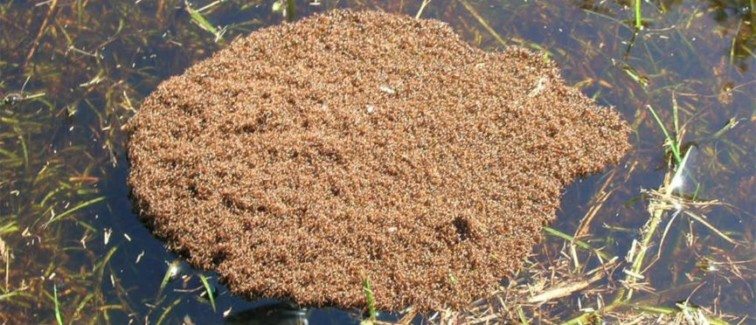
You have probably seen the images of floating red fire ants in Houston from news sources all over the nation. It begs the question, what is it about flooding that attracts these insects?

You have probably seen the images of floating red fire ants in Houston from news sources all over the nation. It begs the question, what is it about flooding that attracts these insects?
If you’re from the Gulf Coast area, it may not be your first time witnessing this phenomenon. Unfortunately, with the devastation of Hurricane Harvey, these critters have found their way further inland, floating in huge, dense masses.
When fire ants’ homes (which are tunnels, sometimes as deep as four feet into the ground) begin to flood, they cling together to rise to the water’s surface. Not only has flooding brought fire ants out of the woodwork, but they are also more fire ants in the fall since they have had all summer to grow their colonies. The water actually helps them get around, and when working in masses they can cause a significant amount of damage – something Houston doesn’t need on top of everything else.
How do fire ants stay afloat?
The fire ants in these floating masses are constantly moving. Those at the bottom of the pile eventually climb their way to the top, and those at the top move down, endlessly revolving. If you try to disturb them by throwing an object at them, they will link together by their legs to form around it, which allows them to move more fluidly. Their bodies are also hydrophobic, meaning they repel water. When water does come into contact with a fire ant, it beads up like droplets on the surface of their body.
Are fire ants dangerous?
If you’ve ever been bitten by a fire ant you know how painful and aggressive they can be. They are very sneaky and will latch onto the hairs of the body’s arms and legs, and once one bites you it sends out a pheromone that tells the rest of the clan to bite. This isn’t even the worst of it. Fire ants can be even more destructive when they work together in these large groups. They are attracted to electrical junction boxes and when congregated, can cause equipment to malfunction. Because they live in the ground, they can also cause damage to vegetation.
Because of their fluid movement, floating ant masses can easily find their way through building crevices. The best way to combat this is by sealing around potential entrances into your home, but given the additional challenges post flood – it can save time and trouble by seeking the help of a professional.
What to do if you see a floating ant colony?
There’s not much you can do to get rid of a mass of red fire ants safely. Some suggest that dumping soap onto them will cause them to detach from each other and sink. However, this is not foolproof and can cause the ants to become even more aggressive and dangerous. The best thing to do if you spot or suspect fire ants is to seek the help of a professional.
Want to know more about these pests habits? Check out their page in the pest library.
Don’t hesitate to contact Holder’s for more information about how to keep these pests at bay.